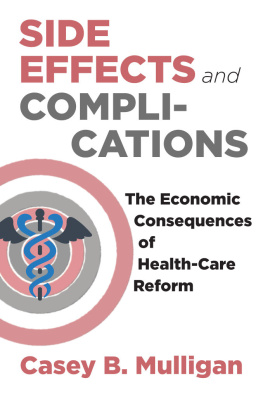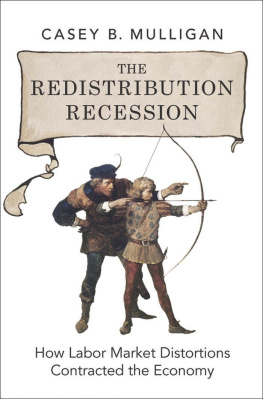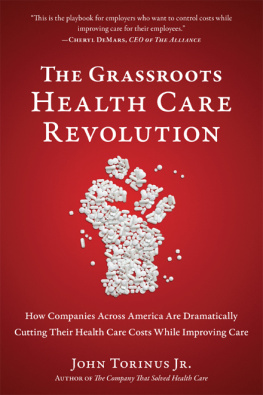Casey B. Mulligan
All rights reserved. Published 2015.
Mulligan, Casey B., author.
Side effects and complications : the economic consequences of health-care reform / Casey B. Mulligan.
Includes bibliographical references and index.
ISBN 978-0-226-28560-3 (cloth : alk. paper)ISBN 978-0-226-28574-0 (e-book) 1. Health care reformEconomic aspectsUnited States. 2. United States. Patient Protection and Affordable Care Act. I. Title.
This paper meets the requirements of ANSI/NISO Z39.48-1992 (Permanence of Paper).
With thanks to the others enrolled in the University of Chicago Maroon plan in the year she was born.
In a way, this book is an unplanned sequel to the 2012 The Redistribution Recession, where I looked at new assistance programs primarily for the unemployed and poor and their effects on labor market aggregates. Most of the programs were supposed to be temporary measures to help people endure the recession. I was writing shortly before their sunset, looking back at labor market dynamics as the programs came on line and making projections for the path of the labor market through the end of 2013 as the last of the temporary provisions expired. Sure enough, by the end of December 2013 the final expiration occurred with the termination of the last long-term unemployment benefit package. Also as expected, the labor market had only partly recovered, more by some measures than others.
But last year it became clear that safety net programs were not getting back to what they used to be. The Affordable Care Act is going ahead with relatively little modification, and it is going to be a lot more than a Medicaid expansion. The generous middle-class premium assistance provision in the 2009 federal stimulus law is reemerging larger, permanent, and more ambitious as a combination of health insurance assistance and employer penalties that help not only people laid off from work but also early retirees, part-time workers, and people who quit their jobs.
New and better data are always welcome, but having seen and analyzed the 2009 premium assistance provision as well as several other safety net measures, I felt there was little reason to wait before seriously analyzing the labor market incentives in the health reform. Moreover, in writing and talking about the first book I learned a lot about clearly explaining the basic labor economics and public finance without sacrificing the numerical accuracy of the conclusions.
Anyone interested in economic performance over the next several years has to understand the contents of the Affordable Care Act from a labor market perspectiveits vastly more important than, say, the interest rate on fed fundsand the first half of this book is, so far, the only comprehensive and user-friendly introduction to the topic. It is about recognizing a tax as economics does, regardless of what politicians call it. It is about detecting the difference between large taxes and small ones. None of this is technical: it just requires data about the structure of our labor market, which I present in a sequence of tables and charts, and arithmetic. But it is conceptual in that the reader sometimes has to dispense with conventional terminology and look at what provisions in the law actually do to create rewards and punishments. Withholding benefits from people because they work and earn is hardly different from telling them to pay taxes on their work and earnings.
The second half of the book looks at the economic consequences of all of the new taxes, also with attention to distinguishing small effects from large ones. Sometimes, as with the application of Adam Smiths equalizing differences, arithmetic and measurement can be enough to do the job. Other times, as in , more mathematical analysis is required. The rewards are several surprises about our economy, regardless of the readers level of technical sophistication.
I thank my family, Tsega Beyene, and Mekdes Yohannes for helping me dedicate the time needed to write a bookyet again! I would understand if they asked Congress to take a break from creating big social programs for a while. And not to repeal any, either! As readers will notice, Sherwin Rosen did a lot to make Adam Smiths equalizing differences ready for quantitative policy analysis. Gary Becker taught economists at the University of Chicago and elsewhere to pay attention to what economics has to say, regardless of how inconvenient or ignored it might be, and encouraged me to finish this book.
Matt Kahn, Glen Weyl, Jorge Garcia, and Saachi Gupta carefully read early drafts of the manuscript. I benefited from comments by Trevor Gallen, Josh Archambault, Jeff Brown, James Broughel, John Cherf, John Cochrane, David Cutler, Bill Dougan, Merle Erickson, Diana Furchtgott-Roth, John Goodman, Robert Graboyes, Paul Gregory, Joe Jackson, Pamela Kelly, Dan Kessler, Arnold Kling, Amanda Kowalski, Eddie Lazear, Kristen Lepore, John McDonough, Bruce Meyer, Jared Meyer, Magne Mogstad, Jack Mulligan, Derek Neal, Matt Notowidigdo, Tomas Philipson, Yona Rubinstein, Rob Shimer, Kosali Simon, Don Taylor, Kevin Tsui, Rob Valletta, Paul Winfree, several economists at the Congressional Budget Office, several anonymous referees, and graduate students, undergraduate students, and seminar participants at the University of Chicago; Hoover; Suffolk University; Texas A&M; UNC-Chapel Hill; the Federal Reserve Banks of Atlanta, Chicago, Minneapolis, and St. Louis; and Western Kentucky. Clemson University even held a seminar while I was absent.
Kevin McKenna and Josh Mills also helped with their comments and suggestions on my posts at nytimes.com about related topics. I also appreciate the assistance of Ada Barbosa and Getfridays Nithin, the financial support of the George J. Stigler Center for the Study of the Economy and the State, and support from the University of Chicagos Division of Social Sciences during a part-year leave of absence that allowed this book to get started.
A technical version of this book was completed in May 2014 and released as a self-published e-book three months later. In preparing the manuscript for the University of Chicago Press, I rewrote much of the prose to include more examples and cut out technical derivations.. The final manuscript preparations were finished in November 2014.
Additional appendixes, updates, and bonus features related to this project are available at www.acasideeffects.com.
The Paradox of Affordability
In our unbelievably rich land, the quality of health care available to many of our people is unbelievably poor, and the cost is unbelievably high.
Senator Edward M. Kennedy (December 9, 1978, speech at the Democratic National Committee midterm convention)
As the nation has become richer and health technologies have advanced, health care has become capable of delivering results ranging from new knees and hips for the elderly to a good chance at a long life for premature babies, to peace of mind for patients and their families. At the same time, spending on health care has grown faster than the economy itself. Millions of people pay a significant portion of their income, often in the form of voluntary deductions from their paychecks that go toward health insurance premiums, so that they and their families can access good doctors, hospitals, pharmaceuticals, and medical devices when needed. Many people take jobs solely for the purpose of paying for their health insurance. The magnitude of their sacrifices demonstrates the importance that people ascribe to health care.








